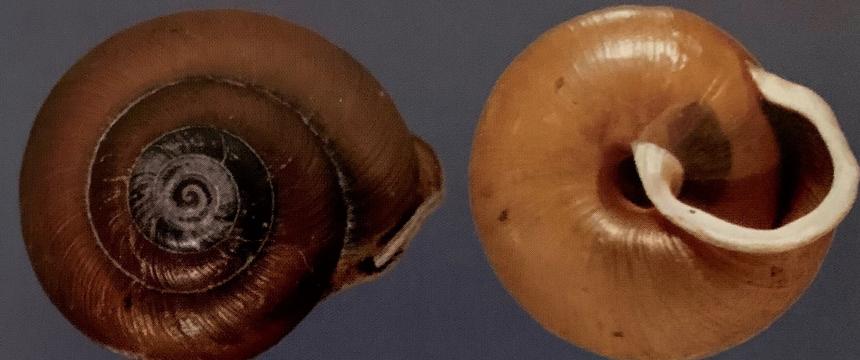Low-
Moderate
The dry land forestnail's population size is low and the trend is unknown. These snails are in the Family Polygyridae. Snails in this family are of conservation concern because they have specialized habitat requirements. Snails do not readily disperse and populations are isolated. They are vulnerable to alteration of their habitat.
Description and Range
Physical description
The dry land forestsnail is a relatively large air-breathing land snail in the Polygyridae family that lacks an operculum (a plate that closes the opening of a mollusk’s shell). The shell measures 0.7 to 0.9 inches wide with five-1/2 whorls, and 0.4 to 0.5 inches high. It has faint ridges, and the color ranges from light buff to cinnamon brown. The edge of the shell opening is thick and white in color.
Ecology and life history
The dry land forestsnail is found in open to dry basalt taluses and rocky riparian areas and prefers xeric environments. It appears to be tolerant of varying conditions, and has been associated with habitats such as dry mixed-conifer forest and rocky riparian areas.
It is likely cryptic for most of the year.
Like most terrestrial gastropods, Allogona species are hermaphroditic, having both male and female organs. Allogona species reach sexual maturity at 2 to 3 years. Mating and nesting season occurs in spring and summer. Eggs likely hatch after 8 to 9 weeks after oviposition (egg laying). Juvenile snails disperse from the nest site within hours of hatching. This subspecies may live up to 8 to 10 years, longer than forest-dwelling Allogona species.
Polygyrids are generally herbivorous and fungivorous snails.
Allogona species probably hibernate during the winter.
Geographic range
The original range of the dry land forestsnail probably included sections of the Snake, Columbia, Salmon and lower Clearwater Rivers in Idaho, Washington and Oregon. It is a regional endemic that has lost much of its habitat. This subspecies appears to be declining throughout its range. It is now confined to isolated colonies in roadless areas in the lower Salmon and Hells Canyon, mostly in Idaho, and Asotin County in Washington. It is locally common in Idaho, but it appears rare west of the Snake River. A recent survey was unable to locate it at the single known historic collection site in Washington.
Climate vulnerability
Sensitivity to climate change
Low
There is limited information on the sensitivity of this species to climate change. Its habitat includes talus and rocky riparian areas. Activities or events that alter conditions, such as moisture levels, shade, and temperature, may make this species vulnerable.
Exposure to climate change
Moderate
- Increased temperatures
- Reduced soil moisture and/or drought
- Altered fire regimes
Conservation
Conservation Threats and Actions Needed
- Fish and wildlife habitat loss or degradation
- Threat: Road building and maintenance
- Action Needed: Delineate and protect sites
- Resource information collection needs
- Threat: Need distribution data
- Action Needed: Identify sites
See the Climate vulnerability section for information about the threats posed by climate change to this species.
Resources
References
Applegarth, J. S. 1999. Management Recommendations for Cryptomastix hendersoni, the Columbia Oregonian (land snail) v.20, Section 2, in T. E. Burke, J.S. Applegarth, and T. R. Weasma. Management Recommendations for Survey and Manage Terrestrial Mollusks (v. 2). USFS and BLM.
Burke, T. E. 2013. Land Snails and Slugs of the Pacific Northwest. Oregon State University Press, Corvallis, OR. 344 pp.
Burke, T., J. Applegarth, T. Weasma, and N. Duncan. 1999. Management recommendations for Survey and Manage terrestrial mollusks, ver. 2.0. USDA Forest Service, USDI Bureau of Land Management. Available online at http://www.or.blm.gov/surveyandmanage/MR/TM23Species/m2000-003.htm
COSEWIC. 2013. COSEWIC assessment and status report on the Oregon Forestsnail Allogona townsendiana in Canada. Committee on the Status of Endangered Wildlife in Canada. Ottawa. xii + 87pp. (www.registrelep-sararegistry.gc.ca/default_e.cfm).
Duncan, N. 2009. Vespericola columbianus depressa. Species Fact Sheet. Interagency Special Status/Sensitive Species Program, Forest Service, Bureau of Land Management.
Edworthy, A., K. Steensma, H. Zandberg, and P. Lilley. 2012. Dispersal, home range size and habitat use of an endangered land snail, the Oregon Forestsnail (Allogona townsendiana). Canadian Journal of Zoology 90(7):875–884.
Frest, T. J., and E. J. Johannes. 1995. Interior Columbia Basin Mollusk Species of Special Concern. Final Report, Deixis Consultants, Seattle. Prepared for Interior Columbia Basin Ecosystem Management Project, Walla Walla, WA 362 pp.
Steensma, K. M. M., L. P. Lilley, and H. M. Zandberg. 2009. Life history and habitat requirements of the Oregon forestsnail, Allogona townsendiana (Mollusca, Gastropoda, Pulmonata, Polygyridae), in a British Columbia population. Invertebrate Biology 128:232–242.
USFWS. 2011. Endangered and Threatened Wildlife and Plants: 90-day finding on a petition to list 29 mollusk species as threatened or endangered with critical habitat: proposed rule. Federal Register 76 (No. 193, October 5, 2011): 61826-61853.
